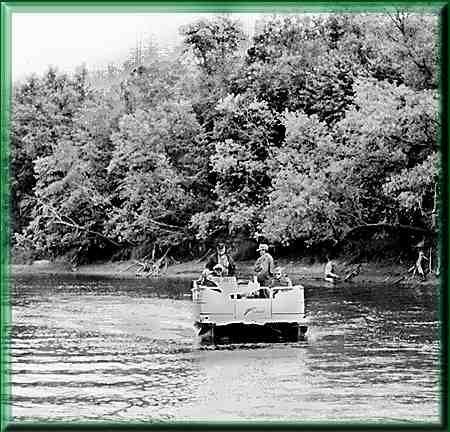|
To the Tidings Newsletter Index Page  The Official Newsletter of the Mississippi Headwaters Board |
|
To the Tidings Newsletter Index Page  The Official Newsletter of the Mississippi Headwaters Board |
| Volume 12, Number 9 | October 4,1996 |
|
River's Healthy Future Goal of Mississippi Communications The growth of population in the eight Mississippi Headwaters counties should be accommodated without compromising the ecological conditions of the Mississippi River and its watershed, according to the Mississippi Headwaters Board Advisory Committee. The committee concluded its second communications planning meeting in Walker September 23rd by adopting this goal of responsible growth. The committee also recommended specific strategies to recruit river property owners and an evaluation program. The committee of 26 citizens who live on or near the river in Northern Minnesota advises the Mississippi Headwaters Board. Dick Brooks and Michael Goldberg, of AccessMedia, facilitated the planning process. The advisory committee recommended that the MHB evaluate whether this goal is met. The Board ought to inventory which areas of the 400-mile river corridor are undisturbed, or in natural, conditions, the committee said. This inventory would be based on aerial photos and be reviewed and updated regularly. Secondly, the MHB should convene focus groups of river property owners and interview them to determine how well the public understands practices that protect river values, how important the health of the river is to them, and whether or not they are willing to adopt practices that protect river values. Finally, the Advisory Committee accepted the suggestion of the Big Sandy Lake Watershed Project to jointly develop a communications program where area Realtors inform shoreland property purchasers about practices that protect water quality, such as minimizing vegetation removal and alterations of the natural topography of the lot.  Aitkin County officials toured hardwood forest management sites on the Mississippi River September 16th. County Assistant Land Commissioner Mark Jacobs is the author of "Mississippi Headwaters Forest Steward Booklet" which describes practices to protect aesthetics, water quality and wildlife habitat. The watershed project proposes to "certify" Realtors who advise purchasers of best management practices. The certification can be used by Realtors in their own promotion. Advisory committee members selected individuals who have purchased shoreland property within the past 24 months as the most effective target for messages about river protection. Tina Smith, a Twin Cities based public relations consultant, supported their conclusions. Smith used focus groups to assess what people know about the Mississippi River and its protection. "We found that pollution was people's primary concern for the river," Smith said. "We also found a big gap between what people knew about pollution and what resource managers were talking about." The McKnight Foundation hired Smith's firm to investigate attitudes towards Mississippi River stewardship in the Twin Cities, Winona and on the Minnesota River. People's concerns for the Mississippi fall into three categories: human health, because the Mississippi is a source of drinking water for one quarter of the state's population; providing future generations with a clean river, and enjoying recreation on or near the river, Smith said. Finally, accountability and responsibility were powerful themes when people talked about the Mississippi, Smith said. "People believe that if you mess up, you should be accountable for cleaning it up and that it is the job of government to hold people accountable," she said. "People said that they were limited in what they could do to protect the river, but they still wanted to know what they should do. That is a very optimistic and empowering response," Smith added. Next meeting of the Board's Advisory Committee is Monday, November 18, in Walker.  Protecting River Islands The Mississippi Headwaters Board is seeking comment on a draft proposal to provide protection strategies for the dozen or so islands in the Mississippi River and its lakes that are privately owned and are capable of supporting development. Current river protection rules work from the shoreland out to the land; the Mississippi Headwaters Ordinance does not protect islands. Representatives of tribal, county, state and federal government have been asked for review and comment. Any changes must be adopted by the eight member counties of the MHB and the Minnesota Legislature to be effective. A preliminary meeting on islands will be held Monday, November 18th in Walker. Erosion Inventory Project Begins in Headwaters An inventory of locations on the Mississippi Headwaters subject to erosion begins this month. Bonnie Goshey, Crow Wing County Soil and Water District Technician, heads the study. U.S. Geological Survey quad maps will be the base for the project. Information from county soil surveys showing slope and soil erodibility will be mapped onto the topo map, with the soil survey adjusted to the topo map scale. Then, a database identifying, locating and ranking erosion problems using slope and soil erodibility factor 'K'. The last step will be ground truthing sites located on the maps and evaluation using a soil erosion index for rivers, assessing condition of bank, condition trend, vegetative cover on bank, cause of erosion, depth and current of river, size of eroded area and soil texture will be used at each location. The resulting information can be used to guide funding of erosion control methods. A planning meeting occurred September 26th. |
|
© 1996 All images and copy may not be used without permission from the Mississippi Headwaters Board. To The Tidings Newsletter Index Page |